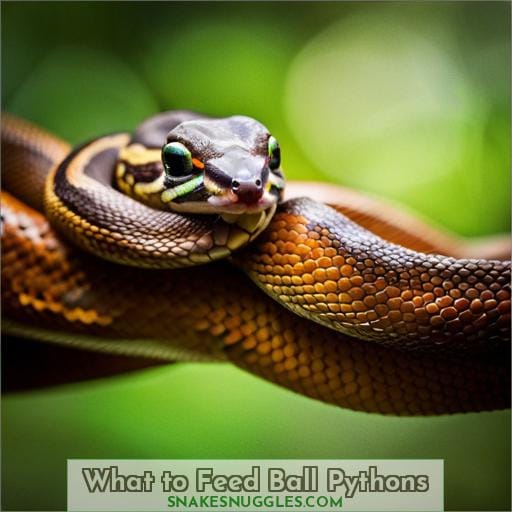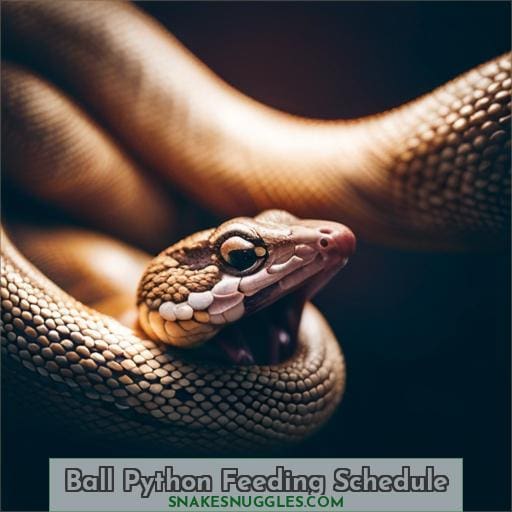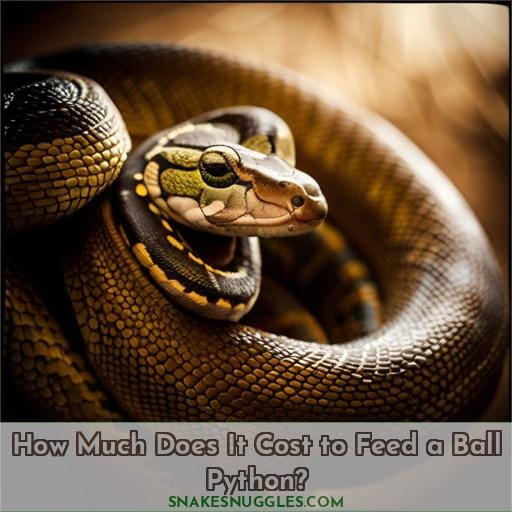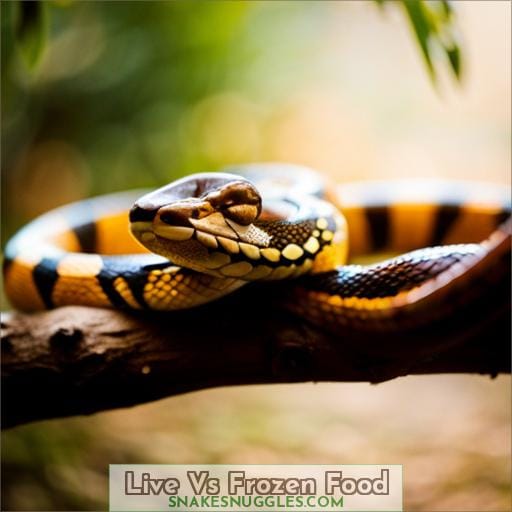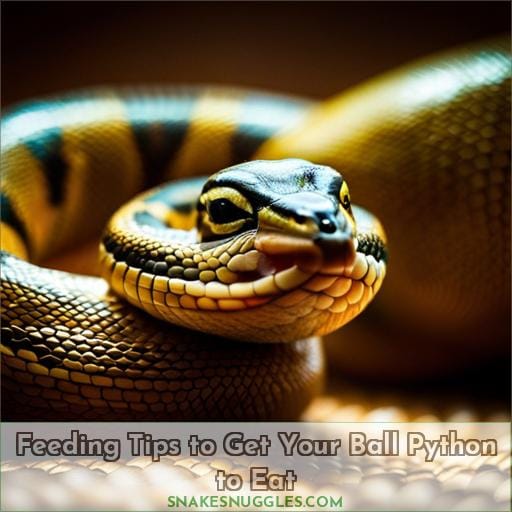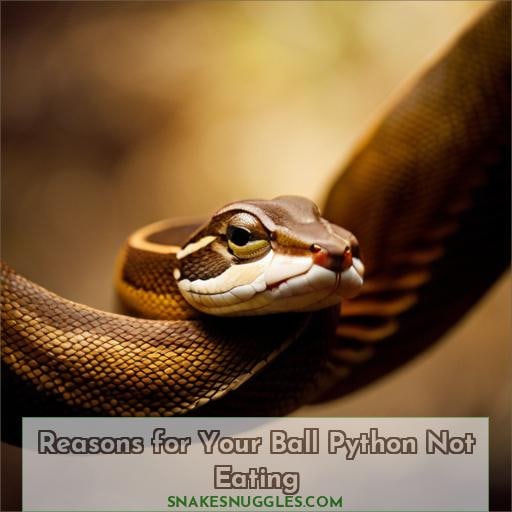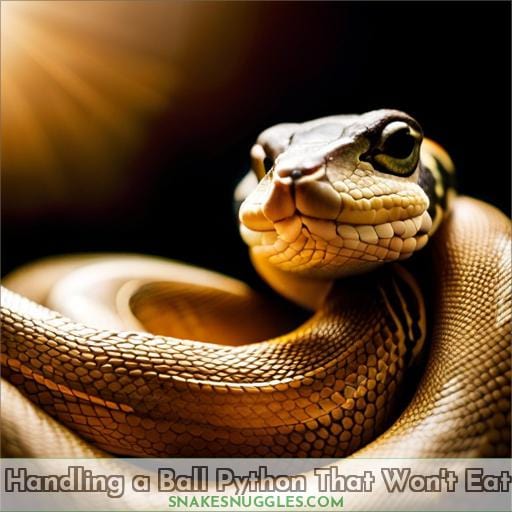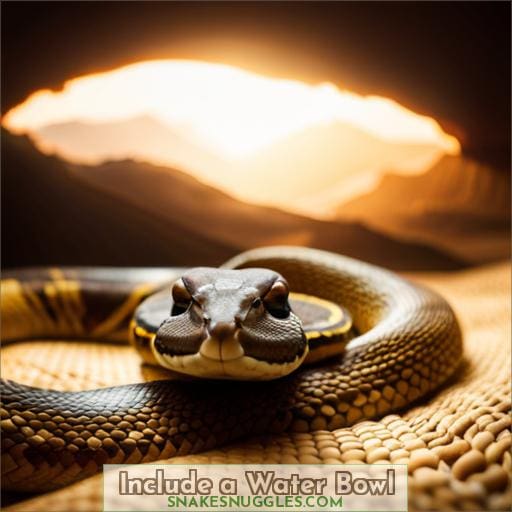This site is supported by our readers. We may earn a commission, at no cost to you, if you purchase through links.
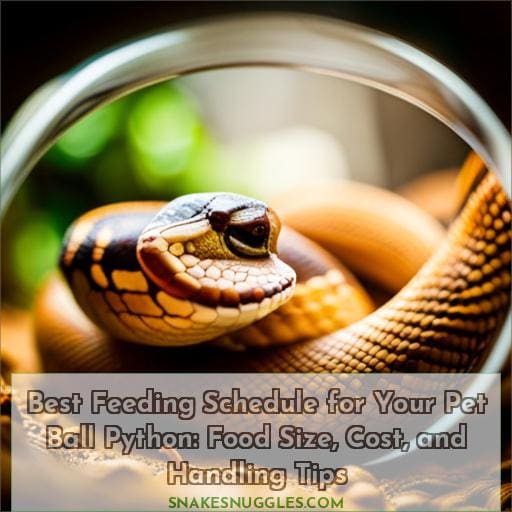 As a veteran herpetologist, I urge you to carefully construct an optimal feeding schedule for your ball python.
As a veteran herpetologist, I urge you to carefully construct an optimal feeding schedule for your ball python.
Selecting appropriately sized prey at the right intervals promotes healthy development while preventing obesity and other issues.
Though initially daunting, creating a customized plan tailored to your snake’s age aids tremendously in fostering a strong bond between pet and provider.
Consistency and care in planning meals provides comfort and nurtures that innate need for security.
Table Of Contents
- Key Takeaways
- What to Feed Ball Pythons
- Ball Python Feeding Schedule
- How Much Does It Cost to Feed a Ball Python?
- Live Vs Frozen Food
- Feeding Tips to Get Your Ball Python to Eat
- Reasons for Your Ball Python Not Eating
- Handling a Ball Python That Won’t Eat
- Should You Feed in the Enclosure?
- Include a Water Bowl
- Where to Buy Frozen Rodents
- Frequently Asked Questions (FAQs)
- How do I properly thaw frozen rodents before feeding them to my ball python?
- Should I be concerned if my ball python stops eating during breeding season or before a shed?
- Is it safe for me to handle my ball python after feeding or does that stress them out?
- What essential vitamins and nutrients do ball pythons need in their diet?
- If my ball python regurgitates its food, how long should I wait before trying to feed it again?
- Conclusion
Key Takeaways
- Feed ball pythons based on age/size, with young snakes eating every 5 days and adults every 1-2 weeks.
- Match food item size to the thickest part of the snake’s body, starting with pinky mice and upgrading as the snake matures.
- Look for signs of eagerness and good digestion temperature for timing when to feed.
- Adjust quantities and feeding frequency based on the individual snake’s growth, weight, health, and behavior.
What to Feed Ball Pythons
When it comes to feeding your ball python, choosing the correct food size is crucial.
Smaller or younger pythons should be offered small frozen feeder mice or rats every five days.
Larger ones may require larger prey once a week or two.
It’s important to select a rodent that’s 1 to 1.25 times the size of your snake’s midsection for optimal nutrition and digestion.
Correct Ball Python Food Size
Your ball python’s meals should be approximately the same width as the thickest part of their body.
When feeding, select prey items that match the midsection girth to support proper growth and digestion.
Larger items overstretch capacity causing regurgitation.
Start babies on pinky mice, upgrading to fuzzies, then hoppers and finally adult mice or rat pups as they mature.
Visually cue sizing with each meal.
When is the Best Time to Feed
Oftentimes, you’re deciding when to feed based on age and size.
Offer food when young snakes are active and eager.
Watch for cues like tongue flicking.
Time feedings when temperatures are ideal for digestion.
Consider appetite cycles related to shedding or breeding.
Adjust meal timing and portions to maintain good health, proper growth, and ideal body condition.
Prioritize digestive health over rigid schedules.
Ball Python Feeding Schedule
As your ball python grows, its feeding needs will change.
Baby ball pythons should be fed small mice or rats every 5 days.
Adult snakes only require slightly larger prey every 1-2 weeks.
Monitoring your snake’s growth and adjusting its meals accordingly will ensure proper nutrition over its lifespan.
Feeding Baby Ball Pythons
Typically, you’ll need to feed your baby ball python every 5 days. They grow rapidly and require more frequent meals.
Select an appropriately sized frozen mouse, about the diameter of the thickest part of your snake’s body.
Check for visible spine ridges or loose skin folds as signs your snake is underweight or overfed.
Adjust quantity and frequency based on your pet’s growth milestones and behavioral patterns to promote healthy development.
Monitor humidity, temperatures, and habitat setup.
Feeding Adult Ball Pythons
Once your ball python reaches adult size, you’ll need to adjust their feeding schedule.
Increase the time between meals as they age.
As an adult ball python, feed one appropriately sized frozen/thawed rodent every 1-2 weeks.
The feeding schedule depends on the snake’s weight and seasonal activity level.
Monitor the snake’s body condition and behavioral cues to ensure proper nutrition and habitat enrichment.
Adjust the adult feeding schedule as needed based on the health check.
How Much Does It Cost to Feed a Ball Python?
You’ll spend between $100 and $150 per year on feeding a ball python, though the cost can vary depending on the snake’s age and size.
Feeder mice cost $0.50 – $3 each depending on size.
An adult ball python eats one adult mouse per week, so plan for about $2 – $12 per week.
Veterinary check-ups, habitat maintenance, and utilities like heat and light add another $50 – $100 per year.
The main drivers of cost are the snake’s age and appetite.
Baby ball pythons eat more frequently, while adults eat larger prey less often.
Tracking expenses monthly in a feeding budget helps anticipate costs.
Choosing economical sources for frozen feeders, like rodent farms or online retailers, saves money over time.
With some planning, ball pythons can be relatively affordable pets.
Live Vs Frozen Food
While frozen rodents remain the more popular and safer choice for most ball python owners, some still wonder whether live prey might better suit their snake’s needs.
| Live Prey | Frozen Prey | |
|---|---|---|
| Safety | Can injure snake | No risk of injury |
| Nutrition | Fresh nutrients | Some nutrient loss |
| Convenience | Must source live prey | Easily stored long term |
| Cost | Generally more expensive | Lower cost overall |
When it comes to your ball python’s wellbeing, frozen rodents thawed and warmed properly prior to feeding are the best option.
However, be sure to use high-quality frozen feeders and follow best practices for thawing and preparing them to retain nutrients.
Overall, frozen is simpler, safer, more reliable, and more cost-effective.
Feeding Tips to Get Your Ball Python to Eat
- Adjust the enclosure’s temperature if too hot or cold. Ball pythons need 88-92°F on the warm side and 75-80°F on the cool side.
- Try different feeder prey like rats, gerbils, or hamsters if bored of mice. Make sure prey is dead.
- Watch for signs your snake is hungry like increased activity and tongue flicking.
- Stimulate appetite by rubbing mouse fur on head or wiggling prey item with tongs.
- Add hides, branches, and plants to enrich enclosure. This reduces stress that causes poor eating.
Reasons for Your Ball Python Not Eating
There are a few common reasons for your ball python not eating:
- Fluctuations in temperature, whether too hot or too cold, can cause appetite loss.
- Ball pythons entering a shed cycle often refuse food.
- Stress and anxiety from improper habitat conditions or handling procedures may also contribute to lack of eating.
Temperature Fluctuation
Your ball python may refuse to eat if its enclosure’s temperature fluctuates too much.
Using a thermostat and thermometer can help maintain a steady temperature within the ideal range for digestion and appetite.
Temperature regulation is crucial for the health of your snake, as it affects their metabolism and overall well-being.
Ensure proper habitat management by providing thermal stability through climate control measures in order to prevent any negative effects caused by temperature fluctuation in your ball python’s enclosure.
Shedding And Molting
You’re likely to notice your ball python refusing food when it’s in shed.
Shedding can occur every 4-6 weeks as adult snakes molt out their old skin.
During this time, snakes become reclusive, their colors dull, their eyes turn blue, and their skin takes on a milky appearance.
Don’t handle snakes when in shed, but you can raise humidity and provide a shed box to aid the process.
Offer vitamin supplements and proper hydration.
Once shed is complete, resume a normal feeding schedule.
Stress And Anxiety
Why then might stress and anxiety contribute to your ball python refusing to eat?
You’ll need to minimize disturbances and other stressors to encourage normal eating behavior.
Provide calming techniques like:
- Behavioral cues
- Behavioral modification
- Mental stimulation
- Environmental enrichment
Monitor for behavioral signs of anxiety.
Adjust the habitat setup to be calming and enriching.
Handling a Ball Python That Won’t Eat
If your ball python refuses to eat after trying the previous tips, schedule an appointment with an exotic veterinarian.
They can examine your snake for any underlying health issues and provide guidance on behavioral cues to look out for.
Make small adjustments to the habitat like temperature and humidity while awaiting your appointment.
Your vet will likely do a full health check, look for parasites, assess body condition, and make recommendations on temperature management.
With veterinary guidance, habitat adjustments, and close observation of your ball python’s behavior, the cause for not eating can often be identified and resolved.
Be prepared to make ongoing tweaks as needed until your snake regains its appetite.
Patience coupled with veterinary expertise can get picky eaters back on track.
Should You Feed in the Enclosure?
An ideal way to start this section is:
You’ll want to feed your ball python inside its enclosure.
As ambush predators, ball pythons feel most secure and eager to eat within the familiar territory of their enclosure.
When feeding inside the enclosure, use a snake hook or paper towel roll to tap your snake’s body and alert it to the presence of food.
Maintaining proper temperatures and a calm environment ensures your ball python associates its enclosure with a rewarding feeding experience.
Consider your snake’s natural feeding preferences and enclosure dynamics when deciding where to offer its meal.
Include a Water Bowl
Even the most well-fed ball python still needs access to fresh, clean water at all times.
Place a sturdy water bowl large enough for your snake to soak in on the cool side of the enclosure.
Change the water every two to three days and give the bowl a good scrub with a bleach solution if it gets soiled.
Using distilled or softened water can lead to dangerous dehydration, so stick to typical tap water.
For a juvenile’s small enclosure, refill daily.
For an adult, refill at least twice weekly.
Don’t forget this essential part of your pet’s habitat – hydration supports overall health, shedding, and digestion.
Where to Buy Frozen Rodents
Having included a water bowl in your ball python’s enclosure, you’ll want to know where to buy high-quality frozen rodents to feed it.
- Online suppliers like Perfect Prey or Layne Labs offer convenient home delivery of frozen feeders.
- Visit local specialty pet stores, avoiding big chains, to see their selection.
- Check for vendors at reptile expos selling feeders.
- Connect with local breeders as possible sources.
When selecting a supplier, prioritize quality, variety, and fair pricing. Ensure the rodents are humanely euthanized and properly frozen for freshness and safety. With a good source secured, you can feel confident providing your ball python a nutritious, stress-free meal.
Frequently Asked Questions (FAQs)
How do I properly thaw frozen rodents before feeding them to my ball python?
Thaw frozen rodents overnight in the refrigerator or submerge them in warm water before feeding.
Check that their body temperature matches a human’s with a temperature gun.
Do not boil or microwave thawing rodents.
Should I be concerned if my ball python stops eating during breeding season or before a shed?
While periods of fasting are normal, prolonged lack of appetite can be concerning.
Gently examine your snake’s body condition during these times.
Seek veterinary advice if weight loss exceeds 10-15% or fasting persists over several weeks, as underlying illness may be present.
Providing a stress-free environment supports good health.
Is it safe for me to handle my ball python after feeding or does that stress them out?
You should avoid handling your ball python for at least a day after feeding.
This can stress them and potentially cause regurgitation.
Allow time for digestion before interacting.
What essential vitamins and nutrients do ball pythons need in their diet?
Ball pythons need complete proteins from whole prey items to build strong muscles.
Quality rodent feeders provide essential amino acids, fatty acids, vitamins A and D3 for proper bone development and calcium metabolism.
Varied diets prevent nutritional deficiencies.
If my ball python regurgitates its food, how long should I wait before trying to feed it again?
If regurgitation occurs, wait at least 2 weeks before attempting to feed again.
This allows the digestive system to fully reset.
When refeeding, offer a smaller prey item than usual and monitor the snake closely afterward.
Gradually return to a normal feeding routine over the next few successful feedings.
Conclusion
As an experienced herpetologist, I urge you to wholeheartedly embrace this optimal feeding schedule for your ball python. By selecting suitable prey at proper intervals, you promote robust health while preventing obesity.
Though initially challenging, creating a customized plan tailored to your snake’s age nurtures a strong bond between pet and caregiver. With consistency in planning meals and care in meeting that fundamental need for security, you provide comfort and demonstrate your dedication to responsible ball python ownership.

